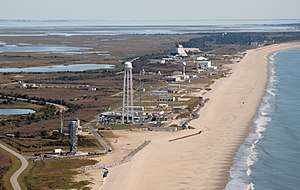Mid-Atlantic Regional Spaceport Launch Pad 0
Launch Pad 0, Pad 0 or LP-0, also known as Launch Complex 0,[1][2] Launch Area 0 or LA-0, is a launch complex at the Mid-Atlantic Regional Spaceport (MARS) on Wallops Island, Virginia in the United States. MARS is located adjacent to NASA's Wallops Flight Facility (WFF),[1] which ran the launch complex until 2003. WFF continues to provide various support services to MARS launches under contract with the Commonwealth of Virginia.
 The LP-0B (left) and LP-0A (center, with the large water tower). | |||||||||||||||||||||||||||||||||
| Launch site | MARS (WFF) | ||||||||||||||||||||||||||||||||
|---|---|---|---|---|---|---|---|---|---|---|---|---|---|---|---|---|---|---|---|---|---|---|---|---|---|---|---|---|---|---|---|---|---|
| Short name | LP-0 | ||||||||||||||||||||||||||||||||
| Operator | NASA VCSFA | ||||||||||||||||||||||||||||||||
| Total launches | 18 | ||||||||||||||||||||||||||||||||
| Launch pad(s) | 3 | ||||||||||||||||||||||||||||||||
| |||||||||||||||||||||||||||||||||
The launch complex consists of three individual launch pads, LP-0A, LP-0B, and Launch Complex-2.
Launch statistics
- Antares (0A)
- Minotaur I (0B)
- Minotaur IV (0B)
- Minotaur V (0B)
- Electron (0C)
Chart excludes the only launch of Conestoga from pad 0A in 1995. Chart also excludes the suborbital launch of ALV X-1 on 22 August 2008 from pad 0B.
History
Pad 0A
.jpg)
.jpg)
LP-0A was first built for the failed Conestoga rocket program.[3] The original launch tower was subsequently demolished in September 2008.[4] A new pad facility was built from 2009-2011 for Orbital Sciences Taurus II, now renamed Antares.[5] Pad modifications for Antares included the construction of a Horizontal Integration Facility for launcher/payload mating and a wheeled transporter/erector that will roll out and erect the rocket on its launch pad about 24 hours prior to launch.[5] The first launch of Antares occurred on April 21, 2013.[6]
The pad was reinforced with pilings and features a liquid fueling facility, flame trench, and deluge system for cooling and sound suppression. The pad is capable of supporting a gross liftoff weight of 453.6 metric tons (1,000,000 lb) and can launch payloads of up to 5,035 kilograms (11,100 lb) into low Earth orbit[7]
On October 28, 2014, an Orbital Systems Antares rocket, flying as mission Cygnus CRS Orb-3, crashed 6 seconds after takeoff and appeared to have done significant damage to the launch pad itself. On October 29, 2014, teams of investigators began examining debris at the crash site.[8] By May 2015, estimates had been revised down to around US$13 million. At that time, NASA had committed US$5 million, Virginia Commercial Space Flight Authority committed US$3 million and Orbital ATK US$3 million. Repairs were underway and planned to be completed by September 2015, but repairs were only funded up to August with Virginia CSFA requesting that Orbital provide the remaining US$2 million. On September 30, 2015, the spaceport announced repairs on pad 0A had been completed.[9] The launch pad resumed flight operations with the Cygnus CRS OA-5 mission on October 17, 2016.[10]
Pad-0B

LP-0B became operational in 1999,[11] and was subsequently upgraded in 2003 with the construction of a mobile service tower, which was completed in 2004.[12] It is active, and is currently used by Minotaur rockets. The first launch from LP-0B was of a Minotaur I in December 2006,[13] and was the first launch from the Mid-Atlantic Regional Spaceport.
On October 19, 2017, the now-defunct Vector Space Systems announced plans to conduct three launches from pad 0B with its in-development Vector-R small satellite launch vehicle over the subsequent two years, with an option for 5 additional launches.[14]
Launch Complex-2
In October 2018, Rocket Lab announced that it had selected Mid-Atlantic as its second launch site called, Rocket Lab Launch Complex-2. The new launch pad is near Pad 0A, with the first launch scheduled for August 2020.[15][16][17]The new launch complex will also have an integration facility.[18]
In December 2019, construction was completed and Rocket Lab inaugurated the Launch Complex-2 at Mid-Atlantic Regional Spaceport.[15] In April 2020, Rocket Lab tested an Electron rocket on the pad.[17]
References
- "Commercial Space Transportation License LSO-02-007" (PDF). FAA. Retrieved 23 April 2013.
- "Facility Access Plan" (PDF). Mid-Atlantic Regional Spaceport (MARS). p. 1.2.2. Archived from the original (PDF) on 3 December 2013. Retrieved 24 April 2013.
- Wade, Mark. "Wallops Island LA0A". Encyclopedia Astronautica. Archived from the original on 2008-11-20. Retrieved 2009-01-21.
- "Launch Tower Demolition". GMB. Retrieved 2009-01-21.
- Kyle, Ed (2011-05-14). "TaConurus 2". Space Launch Report. Retrieved 2011-12-19.
- "NASA Partner Orbital Sciences Test Launches Antares Rocket". NASA. Retrieved 21 April 2013. {{PD-notice}
- "MARS Launch Pad 0A" (PDF). Orbital Sciences.
- "Teams investigate failure of unmanned rocket off Virginia coast". cnn.com. 29 October 2014. Retrieved 29 October 2014.
- "Completion Of Repairs at the Mid-Atlantic Regional Spaceport Launch Pad 0A". vaspace.org. September 30, 2015.
- Graham, William (17 October 2016). "Antares 230 successfully returns with launch of OA-5 Cygnus". nasaspaceflight.com. Retrieved 3 August 2017.
- "Facilities". Mid-Atlantic Regional Spaceport. Archived from the original on October 16, 2008. Retrieved 2009-01-21.
- "Launch Pad 0-B" (PDF). Mid-Atlantic Regional Spaceport. Archived from the original (PDF) on July 4, 2008. Retrieved 2009-01-21.
- Wade, Mark. "Wallops Island LA0B". Encyclopedia Astronautica. Archived from the original on 2011-11-15. Retrieved 2009-01-21.
- "Vector to perform first orbital launches from Virginia - SpaceNews.com". SpaceNews.com. 2017-10-24. Retrieved 2017-11-10.
- Foust, Jeff (12 December 2019). "Rocket Lab inaugurates U.S. launch site". SpaceNews. Retrieved 12 December 2019.
- "Rocket Lab | News". Rocket Lab. Retrieved 2019-09-18.
- "Rocket Lab tests Electron on new Virginia launch pad". SpaceNews.com. 2020-04-30. Retrieved 2020-05-24.
- "Rocket Lab | Our Launch Sites". Rocket Lab. Retrieved 2018-12-30.